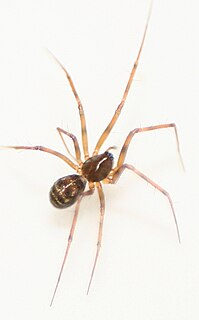
Linyphiidae is a family of very small spiders comprising 4694 described species in 623 genera worldwide. This makes Linyphiidae the second largest family of spiders after the Salticidae. The family is poorly known; new genera and species are still being discovered throughout the world. The newest such genus is Himalafurca from Nepal, formally described in April 2021 by Tanasevitch. Because of the difficulty in identifying such tiny spiders, there are regular changes in taxonomy as species are combined or divided.

Zodarion is a genus of ant-eating spiders from the family Zodariidae. Over 150 species from Eurasia and North Africa have been described as of May 2017.

Dysdera is a genus of woodlouse hunting spiders that was first described by Pierre André Latreille in 1804. They originated from Central Asia to Central Europe.
Troglohyphantes is a genus of sheet weavers that was first described by G. Joseph in 1881. The genus name is a combination of the Ancient Greek τρώγλη (troglo-), meaning "cave (dweller)", and -hyphantes, a common ending for linyphiid genera.

Harpactea is a genus of woodlouse hunting spiders that was first described by W. S. Bristowe in 1939. They are non-web building predators that forage on the ground and on tree trunks at night, mainly in xerothermic forests. During the day, they hide in silk retreats they build under rocks or bark.

Walckenaeria is a genus of dwarf spiders that was first described by John Blackwall in 1833. It is a senior synonym of Paragonatium, as well as Wideria, Cornicularia, Prosopotheca, Tigellinus, and Trachynella.

Lepthyphantes is a genus of dwarf spiders that was first described by Anton Menge in 1866.

Tenuiphantes is a genus of sheet weavers that was first described by Michael I. Saaristo & A. V. Tanasevitch in 1996.

Agyneta is a genus of dwarf spiders that was first described by J. E. Hull in 1911.

Araeoncus is a genus of dwarf spiders that was first described by Eugène Louis Simon in 1884. They closely resemble members of Diplocephalus; both genera have a uniquely shaped of the cephalothorax and a species-specific modification of the tibial apophysis of the pedipalp.
Canariphantes is a genus of dwarf spiders that was first described by J. Wunderlich in 1992. It might be a junior synonym of Lepthyphantes.

Centromerus is a genus of dwarf spiders that was first described by David B. Hirst in 1886.
Improphantes is a genus of dwarf spiders that was first described by Michael I. Saaristo & A. V. Tanasevitch in 1996.
Mansuphantes is a genus of dwarf spiders that was first described by Michael I. Saaristo & A. V. Tanasevitch in 1996.
Mecopisthes is a genus of dwarf spiders that was first described by Eugène Louis Simon in 1926.

Pelecopsis is a genus of dwarf spiders that was first described by Eugène Louis Simon in 1864.











